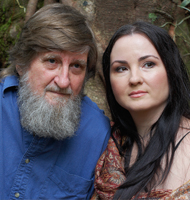INTERVIEW: Stanley and Kaisa Breeden

Stanley and Kaisa Breeden on Wildflower Country.
The photographs in Wildflower Country are breathtaking in sharpness and tonal detail. Can you explain the techniques used to achieve such stunning results?
Ten years ago, I [Stan] had actually given up film photography (after more than forty years!) in exasperation, as it didn’t give me the results I wished for. Kaisa spent many years with me studying digital photography and how it differed from film. We use this difference to our advantage – digital is much closer to human vision than people realise. Our techniques capitalise on the capabilities of digital, its ability to record wonderful subtleties of light. We always use a tripod and cable release to eliminate any movement or shake on our end, and always photograph in natural light (unpredictable, but wonderful). Then, when developed sensitively you can extract all the colour, tone and detail that you see.
How long has Wildflower Country been in process?
Many years – this book is the culmination of six years of research and perfecting our pioneering techniques in digital photography. When we felt we were ready, we thought, ‘What would be the most fantastic subject for our kind of photography?’ and WA’s southwest was an obvious choice. We were in WA for four months, travelling what we call ’the wave’ of flowering that occurs from the north to the south during spring. Then it was back home to work on the writing and selecting and processing of the pictures for a year.
What is typically involved in producing a single photo?
A single image in Wildflower Country could have taken hours to capture. Sometimes days. We worked outside, in the changing light, in the frustrating and near-constant wind gusts. I would set up the tripod and camera, Kaisa would watch the subject to see if it moved during the shot or series of shots – and if it did, it was back to square one. We would wait for clouds to move, for wind to drop … Additionally, most of the pictures in our book are comprised of several exposures of differing focus, some up to twenty or more! We do this to obtain the expanded depth of field. So it all requires hernia-inducing tenacity and anal-retentive attention to detail.
Once back home, the developing begins. The way we take photographs, the raw images on the back of the camera can look very washed-out and unexciting – nothing like what you saw with your eye. With digital, you take on the responsibility for developing your photographs. Then, once that’s done, Kaisa uses software originally designed for microscopy photography to blend these planes of focus together into a very deep, dimensional picture.
What are your individual roles in this work?
We always work together and our roles do blur, but simply put, I am the photography expert and Kaisa is the processing expert. I am the one who knows all about f-stops and Kaisa is the one that knows about black points. I squint into a lens and Kaisa squints into a monitor. But the whole process from start to finish is always collaborative.
What is the most dangerous/interesting situation you’ve found yourself in while shooting?
Breaking out into a sweat after finding the perfect Kangaroo paw. Kaisa had been hunting for the ‘right’ Kangaroo Paw for weeks – she had the ideal one pictured very clearly in her mind. She found it whilst creeping around in the bush in the frigid early morning mist. We had split up to look for inspiring things to photograph, and Kaisa, heart thumping in her ears, was so excited by this flower she nearly got lost and was babbling and dripping with sweat when she found me.
At the end of our first day in Mullewa, photographing coneflowers, we had remarked over and over how they looked like exploding fireworks. We returned to our cottage that evening, and had just shut the door when we heard loud whistling and explosions. We came out to see the night sky filled with giant luminous ‘coneflowers’ of all colours, fireworks in the local show. It was magical and we took it as a good omen.
How does each of you experience the intersection of technical expertise and artistic interpretation in your photography?
For us there is no art without passion and expertise. Kaisa says she always strives to develop our pictures to their utmost expression of detail and clarity, as if you could reach into them. Understanding how digital sensors record information, how to develop the raw files fully and make the software do what you want it to works hand in hand with artistic judgements about composition and tone, line and colour. The actual process, from the photographing to the developing, whilst technical, is very exciting and creative work. And of course, nature itself is so endlessly inspiring – what glorious forms and colour combinations! This is what drives us.
What is so special about the south-west corner of Western Australia?
Through the alchemy of climate, soil and plant ancestry, one of the greatest expressions of flowering plants evolved in Australia’s southwest. Few places on earth have such a variety of wildflowers of brilliant colour, exciting forms and diverse textures. That is why it is one of the world’s thirty-nine International Biodiversity Hotspots.
It is the International Year of Biodiversity in 2010. How do you see your work – and this book in particular – fitting into this celebration of biodiversity?
Much is said about how we must conserve habitats for fear of their destruction and about how biodiversity is vital for human survival. Our book however is a celebration of the beauty and inspiration that the greatest possible variety of life brings.


